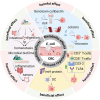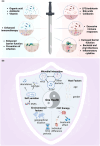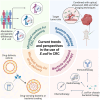Escherichia coli on colorectal cancer: A two-edged sword
- PMID: 39400440
- PMCID: PMC11472651
- DOI: 10.1111/1751-7915.70029
Escherichia coli on colorectal cancer: A two-edged sword
Abstract
Escherichia coli (E. coli) is a ubiquitous symbiotic bacterium in the gut, and the diversity of E. coli genes determines the diversity of its functions. In this review, the two-edged sword theory was innovatively proposed. For the question 'how can we harness the ambivalent nature of E. coli to screen and treat CRC?', in terms of CRC screening, the variations in the abundance and subtypes of E. coli across different populations present an opportunity to utilise it as a biomarker, while in terms of CRC treatment, the natural beneficial effect of E. coli on CRC may be limited, and engineered E. coli, particularly certain subtypes with probiotic potential, can indeed play a significant role in CRC treatment. It seems that the favourable role of E. coli as a genetic tool lies not in its direct impact on CRC but its potential as a research platform that can be integrated with various technologies such as nanoparticles, imaging methods, and synthetic biology modification. The relationship between gut microflora and CRC remains unclear due to the complex diversity and interaction of gut microflora. Therefore, the application of E. coli should be based on the 'One Health' view and take the interactions between E. coli and other microorganisms, host, and environmental factors, as well as its own changes into account. In this paper, the two-edged sword role of E. coli in CRC is emphasised to realise the great potential of E. coli in CRC screening and treatment.
© 2024 The Author(s). Microbial Biotechnology published by John Wiley & Sons Ltd.
Conflict of interest statement
The authors declared no conflict of interest.
Figures





References
-
- Andrews, M.C. & Vasanthakumar, A. (2023) Gut microbiota–a double‐edged sword in cancer immunotherapy. Trends Cancer, 9(1), 3–5. - PubMed
Publication types
MeSH terms
Grants and funding
LinkOut - more resources
Full Text Sources
Medical

